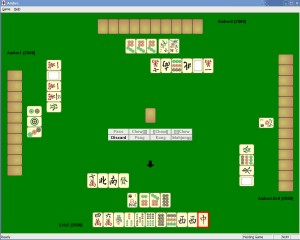Overview

Ambre is a program to play the real Chinese game of Mahjong, not that stupid solitaire version. If you're looking for the dumb matching game, you're at the wrong place. But, if you like the real game of Mahjong, then welcome!
Ambre is network-enabled for Internet play for up to four players. This allows you to play with your friends no matter where they are! Any internet connection will do.
Don't have four players? Not to fear, Ambre comes with Ambre herself, a Mahjong-playing AI. Mix and match human players and artificially intelligent players, so you'll always have enough players to actually play a game! Or just play by yourself against the Ambre AI to practice.
Download
Ambre is available for Windows platforms only. System requirements are pretty minimal. Just download the zip file and unzip it into any directory you like and you're ready to go. No formal installation required.
Instructions
Getting Started
When you first run the game, you'll be greeted with a blank green screen. To start playing, you
need to determine what type of game you're playing. Under the Game menu, you'll notice two
options: Hosting a Game and Connecting to a game. If you're the one starting the game, you want
to host it. Other players will connect to your game.
When you host a game, you can specify what sort of game play you want. You also get to decide how many AI players you want in the game. If you just want to try the game out by yourself, just specify an AI player for each of the other positions and you're ready to start a game. If you have other friends who want to play, leave some spaces open for human players for them to join in.
Playing a Game
When you're playing a game, the program will look somewhat like the picture above. You will see
your hand at the bottom. Each of the other players' hands are concealed. Above each player's hand
you will notice another row of tiles that begins to form as you play through a game. This shows
you all the exposed sets each player has formed, along with the flower/season tiles each player
has accumulated. The row above the exposed row is composed of the discarded tiles of each player.
In the center of the program, you will notice a series of buttons and a single tile. These buttons will activate when you can do the specified action of that button. The tile in the center is merely to tell you what the currently active tile is, so you don't have to keep watching everyone player's actions and get confused as to what is happening.
Arrows will point to the players that the game is waiting for an action from. If there's an arrow pointing down at you, then that means that the game is waiting for you to make a move.
Rules
This is a quick tutorial of how to play Mahjong. It's somewhat like the card game of Gin. What
you want to do is form sets of 3 with a single pair to finish off the hand. So, if you're
playing Mahjong with a 13-tile hand, you need to form 4 sets of 3, plus a pair. You do this
by picking up the 14th tile to make your Mahjong hand.
Sets can be comprised of pongs, which are 3 of a kinds, or chows, which are consecutive series of tiles. A kong is a 4 of a kind, so if you form one, you'll be dealt an extra tile to make up for the tile you lost to make the kong. You cannot form chows with the wind and dragon tiles.
On each turn, you are dealt a tile, or received a tile by forming a chow/pong/kong, and then you must discard a tile to bring your hand back down to the appropriate number of tiles. Play runs in the counter-clockwise direction until someone wins or the game ends in a draw when the number of remaining tiles that can be dealt has reached a critical point.
AI
The Ambre AI has two different playing styles that you can choose from. The Naive Ambre AI makes
its moves without thinking of what the other players are doing. It is only trying to win as fast
as it can. The Intelligent Ambre AI plays somewhat more realistically, considering what each
other player is doing to decide what it feels is the best move to make.